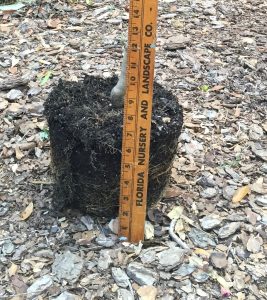Trees and shrubs can be purchased in many sizes, most are no smaller than a one gallon size, and many go up to 7 gallon (or larger). Because of both size at planting and maturity, cost of plants, and large root spread, planning for proper placement before planning is important.

1. Always call before you dig: Call Sunshine811 (800-432-4770) for free visit from local utilities to mark locations of underground wires, particularly if installing large trees.
2. Dig hole slightly less deep than the height of the root ball. The height of the root ball in the planting hole should be slightly higher than surrounding soil. This allows for settling, as the soil breaks down.
3. Dig hole 1 ½ – 2 times wider than root ball. The loosened soil on all sides of the root ball will encourage lateral root development.
4. Keep the bottom of hole flat, leaving soil at the bottom of the hole undisturbed as much as possible. This helps prevent air pockets and supports the root ball.

5. Shave off an outer inch or so of the sides and bottom of root ball with knife or sharp shovel. Any remaining circling roots should be pulled away from the root ball prior to planting. This enhances lateral root development.
6. Make sure root ball is well watered – never plant a dry root ball.
7. Do not add amendment to soil in hole unless the surrounding soil is of extremely poor quality. This can create too rich of an environment, discouraging roots from extending into native soil. Native soil is defined as soil that already exists at planting site. If amendments are desired, it is best to apply to the entire bed.
8. Place tree or shrub in hole; examine from all sides to make sure plant is vertical. Backfill with native soil, gently tamping backfill soil in. Use a shovel blade or stick to help settle backfill into space and apply water gently to remove air pockets.
9. Do not add soil to the top of the root ball. Do not ever stomp on root ball. Compacting the soil reduces oxygen necessary for root growth.
10. Rake surrounding soil level and smooth for good drainage.
11. If desired, add a 3”-high ring of soil. This should be removed at the end of the first growing season. Removing this ring will keep roots from developing into this area.
When installing any size of plant, there are some general guidelines to follow.
1. Add mulch to 3” depth in the area surrounding the plant. If you would like to add mulch on top of the root ball, only apply to 1 inch depth.

2. Water the new plant well, making sure adequate water is applied during the plant’s establishment. This is determined by plant species, size of plant, and season.
3. No need to fertilize. Most plants have just come from the nursery and already have been recently fertilized. Additionally, adding fertilizer at planting has no impact on improved survival. In fact, if fertilizer is not applied correctly, roots may burn and injure the plant. Wait at least a few months before fertilizing trees and shrubs.
Where can I find more information?
Planting Shrubs in Florida Landscapes
Planting and Establishing Trees
Establishing Shrubs in Florida Landscapes
For more information, contact UF/IFAS Extension Polk County at (863) 519-1041 or visit us online at http://sfyl.ifas.ufl.edu/polk. The Plant Clinic is open Monday-Friday, 9:00 am-4:00 pm to answer your gardening and landscaping questions. Give us a call or email us at polkmg@ifas.ufl.edu.
If you are not in Polk County, Contact your local UF/IFAS Extension Master Gardener Volunteer Plant Clinic.
The Florida Master Gardener Volunteer Program is a volunteer-driven program that benefits UF/IFAS Extension and the citizens of Florida. The program extends the vision of the University of Florida/Institute of Food and Agricultural Sciences, all the while protecting and sustaining natural resources and environmental systems, enhancing the development of human resources, and improving the quality of human life through the development of knowledge in agricultural, human and natural resources and making that knowledge accessible.
This article was written by Master Gardener Volunteer Molly Griner under supervision of the Master Gardener Volunteer Coordinator and Residential Horticulture Extension Agent Anne Yasalonis.
An Equal Opportunity Institution.
 2
2
